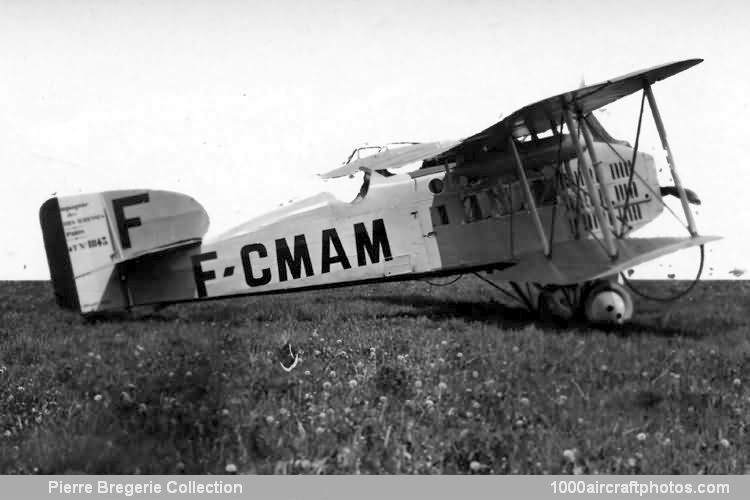07/31/2012. Remarks by Johan Visschedijk: "The Bre 14, one of France's finest bomber and reconnaissance aircraft of WW I, remained in production until 1926, by which time about eight thousand had been built, these were mostly for military use. After the war somewhere in the region of a 150 served in a civilian role, including many converted specially for the carriage of mails, passengers or cargo. The first, and by far the largest, commercial operator of the Bre 14 was Lignes Aériennes Latécoère, which opened its first service, from Toulouse, France to Barcelona, Spain, on December 25, 1918.
This was but the first stage in a prolonged and courageous movement to establish a regular scheduled service between France and South America. In September 1919 the network was extended to Rabat, Morocco, in April 1920 to Casablanca, in October 1922 to Oran, Algeria, and in June 1925 to Dakar, Senegal. In all, 'The Line' acquired no fewer than one hundred and six Bre 14s, most of them of the standard Bre14 A2 (military two-seat reconnaissance) type with minimal modification. The Latécoère fleet also included a few ex-bomber Bre14 B2s, and some civil Bre 14 T and Bre 14 Tbis.
The second-largest operator, with 25 Bre 14 T, Bre 14 T2 and Bre 14 Tbis, was Compagnie des Messageries Aériennes (CMA). This was formed in early 1919 by a consortium which included some of the most famous names in French aviation history – Louis Blériot, Louis Breguet, René Caudron, Henri Farman, Robert Morane, Louis Renault and L. Saulnier – and it began operations on 18 April 1919 with a cargo service between Paris and Lille.
With subsequent expansion it, too, carried passengers and mail, and extended its services from Paris, France to Brussels, Belgium (August 1919), London, UK (September 1919), Amsterdam, the Netherlands (June 1921) and Marseilles (May 1922). The first passenger service was flown on September 19, 1919. Subsequent CMA disposals included two or more to Latécoère, but at least ten were absorbed into the fleet of Air Union, formed in January 1923 from a merger of CMA and CGEA (Compagnie des Grands Express Aériens).
Bre 14s were also operated in small numbers by the Belgian airline SNETA (Syndicat National d'Etude du Transport Aérienne), which had three Fiat-engined Bre 14 A2s; by Compagnie des Transports Aériens Guyanais in French Guiana, which used five or more on a short-lived service from St. Laurent to Cayenne and Inihi in 1919-1920; by the Thailand Royal Aeronautical Service, which operated a non-scheduled mail service between Korat and Ubol, starting in 1922, and possibly passenger services thereafter; by Compania Rioplatense de Aviacion in Argentina, which (also in 1922) flew a service between Buenos Aires and Montevideo for a short period; and in 1928 by Aeroposta Argentinas, a subsidiary of the Latécoère successor, Aéropostale. One Bre 14, possibly Italian-built, was operated by SA Navigazione Aerea in 1925, and two Bre 14 Tbis were flown by the Swedish Red Cross.
The precise designation of the civil Breguet 14 versions is not entirely cÏear. The standard A2 and B2 military versions seated two persons, in separate open cockpits in tandem aft of the wings. The Latécoère fleet included at least 81 A2s and four B2s; there were at least five examples of a version known as the Torpédo, a name signifying 'open tourer' which is believed to apply also to the Bre A2 in its civilian form.
There were two aircraft, possibly more, known as Limousines, a designation which may relate to a known Latécoère conversion which provided a crude cabin enclosure over the rear cockpit. Latécoère carried out considerable overhaul and modification of his Breguet fleet, most of which were purchased as war-surplus military machines. The principal conversion was made for the mail-carrying operations which constituted the bulk of the airline's business. For these operations the aircraft were at first flown as single-seaters, and the mail carried in two streamlined containers, one attached beneath each lower wing.
Later, as the network extended across French North Africa, the mail was often stowed in the rear fuselage. This provided a somewhat lumpy seat in the rear cockpit for a Moorish interpreter, whose presence was deemed necessary after a number of Aéropostale's Breguets had been destroyed in the desert by marauding tribesmen.
The true cabin versions of the Bre 14 seem to have originated with the 14 T2 Salon, a two-passenger version which first appeared registered as F-CMAA in 1919. This housed the passenger within the forward fuselage, with small rectangular windows provided in the upper decking. Breguet also produced in 1919 the Bre 18 T Berline, a larger aircraft based on the Bre 16 bomber, powered by a 450 hp Renault 12Ja engine and seating four passengers.
The final model, the 14 Tbis, combined features of both the Bre 18T and the Bre 14 T2. The prototype, F-CMAL, was flown for the first time on September 13, 1921, and a military ambulance version was also developed. Many Bre 14s were operated, at some period during their lives, on a float landing gear, and in the case of the Swedish ambulance aircraft a ski gear was also in use at times.
Although the pictured F-CMAM carries the designation Bre 14 T on the tail, it is in fact a Bre 14 Tbis. It was registered to CMA on May 23, 1921, in the January 1923 merger it became part of the Air Union fleet. Eventually it was returned to Breguet, but it was destroyed in October 1931."
